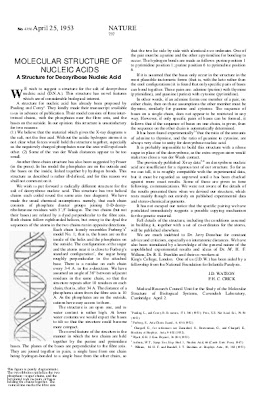Dalla doppia elica a quella quadrupla. Sessant'anni di scoperte intorno al DNA
 Il 25 Aprile 1953 James D. Watson e Francis Crick pubblicarono il loro celebre articolo Molecular Structure of Nucleic Acids. A Structure for Deoxyribose Nucleic Acid (in realtà lo studio si basava sull'analisi delle immagini di diffrazione a raggi X realizzate da Rosalind Franklin ma il contributo della chimica-fisica inglese fu praticamente ignorato) nel quale si descrive per la prima volta la struttura del DNA come una doppia elica.
Il 25 Aprile 1953 James D. Watson e Francis Crick pubblicarono il loro celebre articolo Molecular Structure of Nucleic Acids. A Structure for Deoxyribose Nucleic Acid (in realtà lo studio si basava sull'analisi delle immagini di diffrazione a raggi X realizzate da Rosalind Franklin ma il contributo della chimica-fisica inglese fu praticamente ignorato) nel quale si descrive per la prima volta la struttura del DNA come una doppia elica.Sessant'anni dopo altri ricercatori di Cambridge dimostrano l'esistenza di strutture del DNA a elica quadrupla - G-quadruplex - nel genoma umano.
Le strutture a elica quadrupla erano già state isolate in provetta (Shankar Balasubramanian ha pubblicato un articolo su Nature Chemistry il 10 Ottobre 2010: "Small-molecule-mediated G-quadruplex isolation from human cells") ma nessuno era ancora riuscito a osservarle nelle cellule umane.
Per farlo i ricercatori hanno costruito anticorpi sintetici in grado di legarsi alle quadruple eliche del genoma umano e li hanno dotati di una particolare fluorescenza. Il gruppo, coordinato da Giulia Biffi, è riuscito a generare le proteine anticorpali in grado di rilevare aree del genoma ricche di quadruplex.
I ricercatori hanno anche scoperto che un gene con livelli più elevati di DNA quadruplex è più vulnerabile alle interferenze esterne. La struttura del DNA a elica quadrupla potrebbe essere la chiave per nuovi modi di inibire selettivamente la proliferazione di cellule tumorali.
Andrea Mameli www.linguaggiomacchina.it 20 Gennaio 2013
[Picture: Shankar Balasubramanian in front of a mural in his office representing quadruplex DNA, called ‘Living by the code’ by artist Annie Newman]
Quantitative visualization of DNA G-quadruplex structures in human cells
Giulia Biffi, David Tannahill, John McCafferty, Shankar Balasubramanian
Nature Chemistry (2013)
doi:10.1038/nchem.1548
Published online 20 January 2013
Abstract
Four-stranded G-quadruplex nucleic acid structures are of great interest as their high thermodynamic stability under near-physiological conditions suggests that they could form in cells. Here we report the generation and application of an engineered, structure-specific antibody employed to quantitatively visualize DNA G-quadruplex structures in human cells. We show explicitly that G-quadruplex formation in DNA is modulated during cell-cycle progression and that endogenous G-quadruplex DNA structures can be stabilized by a small-molecule ligand. Together these findings provide substantive evidence for the formation of G-quadruplex structures in the genome of mammalian cells and corroborate the application of stabilizing ligands in a cellular context to target G-quadruplexes and intervene with their function.





Commenti